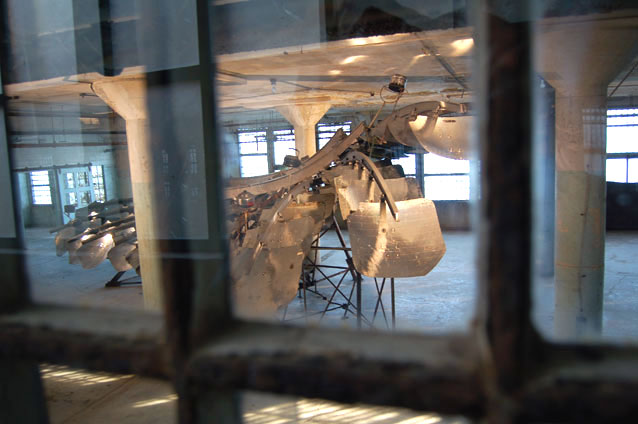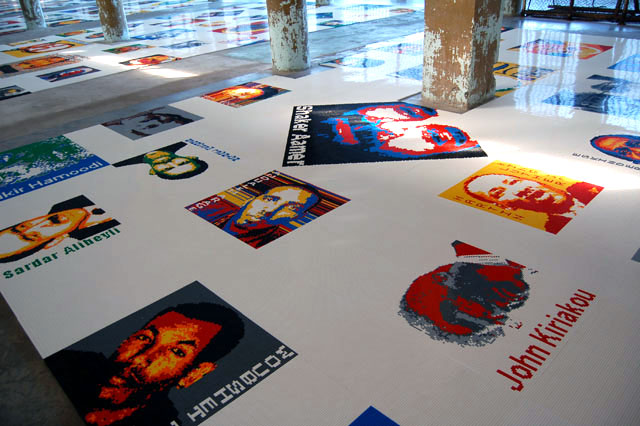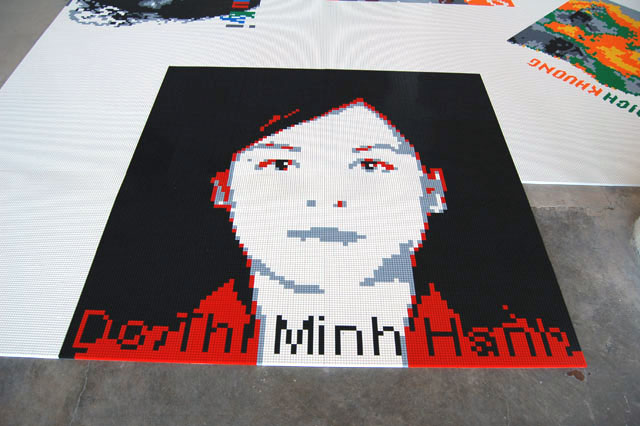First, an admission: I’d never been to Alcatraz and only recently had my first visit. Its histories of isolation and displacement were always amplified in my mind by its sorrowful emptiness. Why would anyone go to Alcatraz, I always wondered – then came Ai Weiwei.
But, to be clear, Ai Weiwei has also never set eyes on the place. The seven site-specific installations around the prison today were conceptualized by the artist from his studio in China, where he remains unable to travel since being detained by the government in 2011. As I wrote in a recent article about his life and art, despite this limitation Ai has cultivated an exceptional ability to work as a “remote control artist,” and has produced many large-scale exhibitions, site-specific projects, music videos, interviews, etc, using the Internet.
Ai developed new work for Alcatraz using research materials and maps delivered to him by Cheryl Haines, executive director of the For-Site Foundation, the non-profit that produced the $3.6M Alcatraz project in partnership with the National Park Service. Haines has also represented Ai Weiwei at her eponymous commercial gallery since 2010.
With this show, the artist has given much consideration to his own experiences of detainment, as well as to the experiences of many others persecuted for acting out against inequity. The strongest works here are sparse sound installations that push the viewer to consider empathy. To rush through the site on a mission to see the work is to miss something of the point.
The most powerful work in @Large is Stay Tuned, a series of sound pieces located in twelve cells in Block A. Visitors enter the tiny rooms to hear recordings of spoken word, poetry and music created by people imprisoned for expressing their beliefs. A single cold stainless steel stool, designed by the artist, is centered in each cell, evoking the solitary nature of confinement. One features a recording of the Robben Island Singers, imprisoned for anti-apartheid activism in South Africa; another features the song that led to the recent imprisonment of members of the Russian punk band Pussy Riot.
Another sound installation, Illumination, is situated in two adjacent psychiatric observation rooms in the former prison hospital. One audio recording features a traditional song of the Native American Hopi tribe, some of whom were the first prisoners of conscience held on Alcatraz, and the other features the chanting of Buddhist monks. The work attempts to draw parallels between the powerlessness of the detained and the mentally ill and to touch upon the possible catharsis offered by chanting in situations of duress. Though these were perhaps the most emotionally loaded sites, the work stops short of the empathy evoked by Stay Tuned.
As disturbing as it is to see these rooms, and the hospital in general, Illumination does not seem to touch upon the history of despair or containment and isolation that resonates within those walls. I was aware of the audio, but I was more mindful of the original tile and how many hands must have gone over its surfaces. Short of locking people up in isolation, it is hard to know if an artwork can achieve the same gravity of such lived experiences. When art tries and fails in such contexts, does spectacle somehow diminish the integrity of history? This is the thorny challenge of site-specific work that engages with the past.
Beyond audio, there are also works that deliver visually stunning results with varying emotional impact. Refraction is a massive sculpture referencing a bird’s wing; it is comprised of reflective panels used for Tibetan solar cookers. The five-ton apparatus looks functional and it appears mechanical, as though it could move if powered, but it is none of these things. The viewer only sees the sculpture from a gun gallery positioned above the former workroom floor where well-behaved prisoners once worked. The broken glass and small rusty windowpanes of the gun gallery obscure the view — there are no clear sightlines to consider the work in its totality, and viewers must choose between considering the art below and the remnants of history literally in front of their eyes. Though the work promises a remarkable image to behold by virtue of its scale, the resulting effect is more subtle.
The work that is not subtle and is bound to be discussed far and wide is Trace, an impressive array of 175 floor-based Lego portraits of people the world over who have been imprisoned for their beliefs or their affiliations. The range of images and craftsmanship is impressive and it is a work that is certain to have wide appeal, from children to technically minded adults. (Many of the newer tech companies have Lego walls in their offices — Ai Weiwei may have cracked the code when it comes to engaging tech upstarts with contemporary art.)
Certainly Trace lends itself well to being documented on social media — the pixilated forms actually coalesce in front of a lens — and given that the island was rigged with wi-fi specifically for this occasion, visitors will be able to post and tweet to their hearts’ content, while also distributing images of these persecuted subjects around the world and communicating to Ai over the ether that his message has been received. Trace isn’t complicated, but it does have many layers of brilliance within its multicolored plastic grids. The fact that these Lego portraits are also the most marketable of Ai’s endeavors on Alcatraz is but one layer. Surely they will be very popular at some art fair somewhere someday. They’re cool.
The positioning of work such as Refraction or Trace in the New Industries building where inmates earned prison wages for assembly work, mostly sewing, raises interesting questions about For-Site’s open call for volunteer labor to assist with production. Given that a very successful Kickstarter was launched — in addition to the project budget raised by For-Site — to pay for the art guides program, the absence of compensation for assembly work seems to perpetuate the art world’s penchant for free production labor. It also appears shortsighted given the site itself and the larger history of prison labor.
In response to questions about the volunteer program, a For-Site representative noted that part of Ai’s practice is to involve the community. Many of his works have engaged this type of participatory making. For-Site recruited 90 volunteers via the Parks Conservancy to work on one piece. This is part of normal operations for the Conservancy, which routinely lines up volunteers to do all kinds of things in the parks.
But is it fair to compare volunteerism for the Parks Conservancy with unpaid production labor for an international artist with blue chip prices in the art market? In the end, the For-Site representative stated noted that Ai Weiwei owns the works, so he can sell them when the show is done. In light of the expansive budget and elaborate infrastructure of paid workers associated with the project, the call for volunteer labor in this scenario seems to counter the social justice message of the exhibition, especially considering recent debates about the value of art and labor within the Bay Area’s meteoric cost of living.
As a privately organized “public” project, @Large circumnavigates the usual processes for public art, as much large-scale work does today. The larger economic implications of the project are still unclear. The exhibition benefits the National Park Service — the New Industries building, among other spaces, was spruced up for the project and the island was wired with wi-fi — but it also has the potential to benefit Alcatraz Cruises, the private ferry company with an exclusive government contract to service the island. As the exhibition dates overlap with typically slower tourism during the winter months, @Large could potentially boost ticket sales as an unusual attraction in the off-season. (See Cy Musiker’s article about securing tickets for more details.)
It is hard to imagine how @Large will impact the Bay Area community in terms of social justice, or if it will at all. Will it raise larger questions about freedom of expression, or the prison system, or public access? What is the function of so-called public art, exactly, in this context — when the work isn’t publicly accessible at all and bears a complex relationship to private interests? @Large seems to be directed beyond the Bay Area public, and aimed towards a much larger, networked global community propelled by the tourists who come in droves to see San Francisco. It is possible to consider Alcatraz as a prison in the larger metaphorical sense, as Ai appears to do in the exhibition, but it would further succeed in the vein of art activism if the project prioritized accessibility and engagement within the local community.
I’ve wondered all along if the visibility of this project will impact Ai’s situation. Can art affect change at that level? If it could, would that be Ai Weiwei’s ultimate artwork — or a great shift in thinking about what art can do, or both? Ai can’t be here, so the work will have to speak for itself. I bought tickets to go back this weekend with a guest, an old friend who has visited many times and yet has never been to “The Rock.” “Finally,” he said to me, “finally you’ll go to Alcatraz – now that it’s about art.”
@Large: Ai Weiwei on Alcatraz opens September 27, 2014 and runs through April 26, 2015; it is organized by FOR-SITE Foundation in partnership with the National Park Service and the Golden Gate National Parks Conservancy. For tickets and information visit for-site.org.


